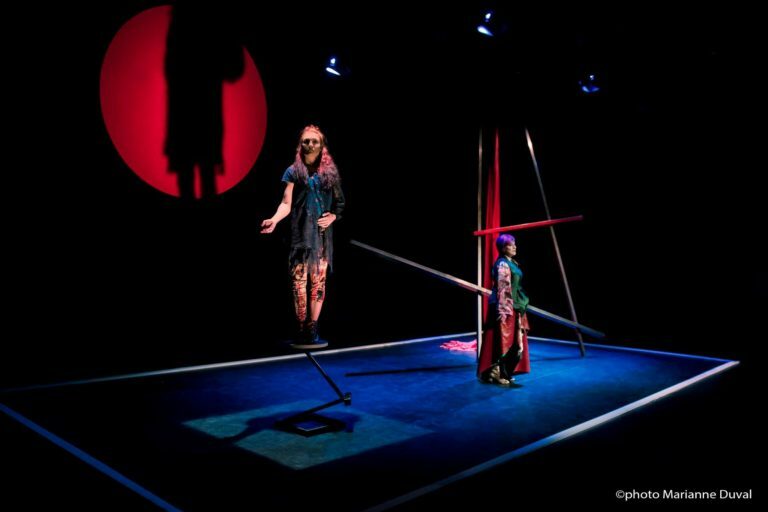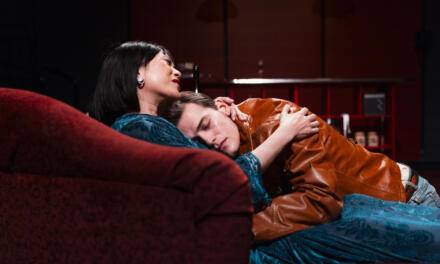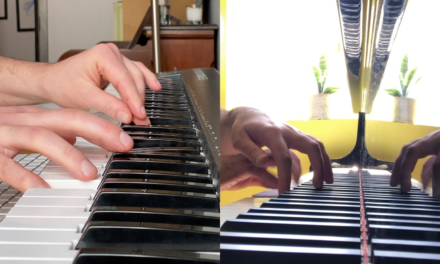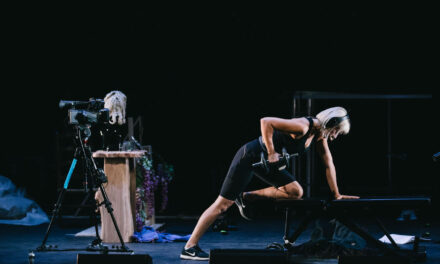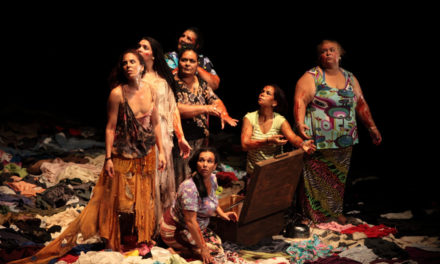The Arts Court Theatre is the perfect intimate space for the experimental performance piece Albumen, produced as part of the TACTIC’s mainstage series. The play, written in English by francophone playwright, Mishka Lavigne, is a reflexion on the relationship between varying artistic gazes and how they apprehend the exterior world.
During these discussions, the set becomes an important part of this collective artistic vision as the visual and material substance of the acting space envelope the actors. Thanks to the well thought-out reflection by director Éric Perron working with a fairly abstract text almost lacking in any stage directions, the result of Perron’s work is impressive. He seeks out all the possible meanings from a text that could have remained profoundly hermetic.
Three performers in the first portion of the evening, move around and climb over a form that resembles a deconstructed version of a painter’s easel. References to painting and artwork are thus from the first moments thrust into the performance space. A huge red round moon-like shape glows in space and soon becomes the background for shadowy highlights of the human body projected into space as a wandering screen looking for a home. Two young people are in conversation. Jessa (Andrée Rainville) the young model, exchanges ideas and feelings with Lucas (Mitchel Rose) working in a blood bank with people who feel they are compelled to donate blood. Lucas is taken with Jessa and wants to get closer to her. He watches her, obsesses about her blood in a deeply erotic way, sees the drops flowing on the floor, as her body becomes a canal pulsing with blood that excites him (Deboer’s costume for Jessa brings that to life in a strong way) while that huge red circular shape could also be a drop of blood that might suggest the pure form of a Kandinsky circle that would bring us back to Jessa’s abstract origins and that is constantly referred to in the conversations among the three protagonists,
Danielle (Margo MacDonald) sees the exterior world through her own distant gaze. She states clearly that photography is a form of voyeurism and her photographic lens lays its gaze on the young girl in a strangely heated conversation.
The photographer, however (Danielle), sees the young girl as an object to be captured by her lens nothing more, while Jessa’s translucent and unbearable eyes, anger and upset the photographer. She would like to dig them out with a needle because those eyes prevent the artist from connecting with her own photographic art no doubt because they are too perceptive.
As the young couple chat and discuss their own special relationship which is less abstract than that felt by the photographer and much more linked to the body, a form of corporeal obsession takes over the young bodies in space and forces them to reveal much confidential information.
s We quickly see how Jessa is precisely one of those beings who lives through her body. Played by an excellent Andrée Rainville with strong emotion and richly felt tension, she climbs up and down a long red silk rope that hangs from the ceiling, allowing this young actress with acrobatic training to swing from the long piece of material to climb over the easel, and straddle the split wooden structure, exciting the gaze of Lucas who is more and more in love with the young model as she reveals her artistic past and the nature of her great potential as a painter….not as an acrobat! . However, as a corporeal presence, her body becomes a form of opposition to her talent as a painter and she evolves into a model who has to control her body and learn how to pose for long periods without moving. Thus her fate and her interaction with Danielle is a form of denial of what she really feels or the authentic nature of her talent.
The discussions evolve towards more complex emotional exchanges. Danielle invites Lucas and Jessa over for dinner. What are those hidden motives? Much is suggested. In fact, the performance is a long string of that which is suggested but never really spoken clearly. Danielle has a passion for red bleeding meat while Lucas is attracted to bleeding bodies and needles that drip with blood from those who donate in his clinic. Love, perversion, cannibalism, vampirism, much is laid out before us in a strangely provocative way that director Perron seems to catch at every turn.
A strangely fascinating encounter of three incompatible creatures who express their deepest desires with much freedom. A dramatic encounter of a living art piece that associates Joan Miro, Constructivism and a disturbing form of Symbolism inscribed in a Fuseli nightmare and anything else you might want to toss in. It’s really quite fun.
This article was originally published in Capital Critic’s Circle on March 21, 2019, and has been republished with permission.
This post was written by the author in their personal capacity.The opinions expressed in this article are the author’s own and do not reflect the view of The Theatre Times, their staff or collaborators.
This post was written by Alvina Ruprecht.
The views expressed here belong to the author and do not necessarily reflect our views and opinions.

